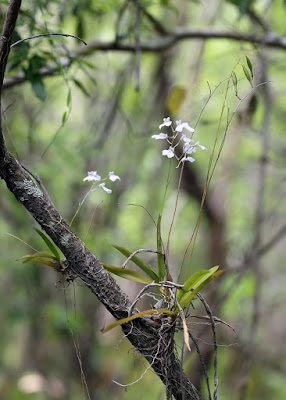Ionopsis utricularioides is native to the state of Florida in the USA, the Caribbean, Mexico, Central America and south to South America. These plants usually grow below 1000 m, but in some habitats they are found even at heights of 1300-1500 m...
Ionopsis utricularioides also called as The Delicate Violet Ionopsis, Cybelion pallidiflorum, Cybelion pulchellum, Cybelion tenerum, Cybelion utriculariae, Dendrobium utricularioides, Epidendrum calcaratum, Epidendrum crenatum, Epidendrum paniculatum, Epidendrum sessei, Epidendrum utricularioides, Iantha pallidiflora, Ionopsis deliciosa, Ionopsis gardneri, Ionopsis pallidiflora, Ionopsis paniculata, Ionopsis pulchella, Ionopsis pulchella, Ionopsis tenera, Ionopsis tenera var effusa, Ionopsis tenera var tomentosa, Ionopsis tenera var violacea, Ionopsis utricularioides f. virginalis, Ionopsis utricularioides var. latifolia, Ionopsis utricularioides var. violacea, Ionopsis utricularioides var. virginalis, Ionopsis zonalis, Scaphyglottis pallidiflora, is a species of the genus Ionopsis. This species was described by John Lindley in 1826.
IDENTIFY IONOPSIS UTRICULARIODES
Ionopsis utricularioides is native to the state of Florida in the USA, the Caribbean, Mexico, Central America and south to South America. These plants usually grow below 1000 m, but in some habitats they are found even at heights of 1300-1500 m. They are usually attached to twigs and boughs of trees or shrubs growing along streams in wet areas but with a relatively dry winter. In damp forests this species quickly becomes a weed, growing on hedges and decorative trees and shrubs.
It is a miniature to medium sized, cool to hot growing epiphyte, which reaching up to 17 cm in height, with ellipsoid, compressed, up to 3 cm long pseudobulbs that bear a single, apical, linear to oblong-elliptic, acute leaf and 2 to 3, 3-17 cm long and 1.2-2.0 cm wide linear or lanceolate, carinate, stiff and imbricate leaves.
The Delicate Violet Ionopsis surround and enfold the rhizome and, a basal, erect, up to 75 cm long, branching panicle, terminating in densely numerous flowers that open in succession over months. The size of the flowers varies from 1.2 to 2.0 cm in length. The flowers can be in every shade from pure white to deep purple, but most often they are lilac or white with red-purple veins on a large, 2-split lip, the length of which is twice as long as the length of the outer whorls. The petals of both whorls may or may not have red-purple longitudinal veins.
IONOPSIS UTRICULARIODES CARE AND CULTURE
Cultural information should only be used as a guide, and should be to be adapted to suit you. Your physical location; where you grow your plants, how much time you have to devote to their care, and many other factors, will need to be taken into account. Only then can you decide on the cultural methods that best suit you and your plants.
Light:
Temperature:
The average temperature of the summer day is 27 ° C, the night 19-20 ° C, giving a daily difference of 7-8 ° C. The average temperature of the winter day is 21-23 ° C, night 16 ° C, giving a daily difference of 5-7 ° C.
Humidity:
Ionopsis utricularioides needs the humidity of 85-90% for most of the year and falls to 80% within a few spring months.
Substrate, growing media and repotting:
Ionopsis utricularioides are generally grown on rootstocks.
Watering:
In natural habitat, rainfall is moderate to heavy for most of the year, and a slightly drier period occurs at the end of winter and early spring. The cultivated plants should be abundantly watered during active growth, but excellent drainage is required. Starting in late autumn, when new growths reach maturity, you should reduce the amount of water, but you should never dry up completely.
Fertilizer:
During the active growth, the plants should be fertilized every week 1/4-1/2 of the recommended dose of fertilizer for orchids.
Rest period:
In winter, Ionopsis utricularioides need less water, but they should not be completely deprived of it for a longer period of time. When reducing the amount of water, fertilization should also be reduced or eliminated.















COMMENTS